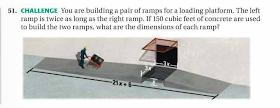On average, some 100 million Americans were employed full-time in 2010-2012 — and 70 million of them either hated their jobs or were simply "checked out," according to a recent Gallup survey of America's workforce.
 And edujokers get pissy that all students need to be engaged in their schoolwork ... my answer to all that is "Yeah, Right. They're just as human as everyone else."
And edujokers get pissy that all students need to be engaged in their schoolwork ... my answer to all that is "Yeah, Right. They're just as human as everyone else."The first big problem is that too many students are encouraged to "think outside the box" before they know what's in the box and use their "high-tech tools and knowledge" before they can use low-tech ones, while teachers are ordered to "keep them engaged and make it interesting."
If you really want to "engage" the students, the first thing you need to do is stop trying.
And. Just. Teach. Math.
- Teach the basics first.
- Build / scaffold from there.
- Show the RealWorld problem after the students understand the abridged version.
- Don't fall prey to pseudo-context.
I think of a problem as a wall, with the solution being to get to the other side. There are lots of ways to get to the other side and there's lots of "other side" to get to ... it's not one specific place. The "other side" includes the spot within arm's-length but it also has that spot way over there across the next hill. Some kids will accomplish one, others will go further.
If the problem isn't very difficult, the wall isn't very tall. If they need an inspiration, a specific skill, or a bit of knowledge first, then that's a step in the stile. I think teaching is a lot about giving them those steps in the stile.
If you can't get over the wall and you don't seem to have a stile that will help, most students quit. If they think they can get somewhere by trying this approach and that one, they'll continue BUT NOT if those steps don't seem to be getting anything accomplished. That's one place where disengagement happens.
 |
| Not even math teachers can stand this one. |
You might have a question such as this one at right (loading ramp) that counters any knowledge the student may already have, such as the actual height of loading ramps in this country, or the fact that the slopes of such ramps would be equal regardless of which side you picked. And there are probably some restrictions on that slope for safety reasons.
Although solving for x is a matter of multiplication and then factoring, there's no particular reason for this. It would be better for all involved if this problem were simply stated as algebra, with no picture or "context", just "Solve for x". There's the second place that disengagement occurs.
PseudoContext is an infection. It festers in the minds of the students. "Why? That's so stupid. Who would ever DO that?" If not excised, it turns gangrenous and can taint everything around it with its stink.
What to do in math class?
Let them feel the accomplishment of mastering the basics first. Small quizzes of 15-20 points that can be retaken until the student is satisfied. Problems are the same each iteration, but the numbers vary.
Continue with the more complicated problems. There will be fewer questions here, with more steps apiece.
Finish with the Real World ... if the RW is appropriate .... and sometimes it isn't. Sometimes, the next chapter IS the "RealWorld Use".
Some Thoughts for the Real World Problem:
- If you can't find that Real World question, please don't fake it and put in pseudo-context. Pseudo-context makes everything you've tried to accomplish into "I'm Never Gonna Use this Bullshit and You Can't Convince Me Otherwise."
- Be sure they can solve it before you give it, and that you've taught the necessary preliminaries.
- Know what answer you'll accept, but be ready for another.
- Guide, nudge, and hint broadly. Let them Google.
- Don't get specific and don't answer the "I wanna be lazy so tell me the answer?" question.
- Don't force collaboration.
- Don't allow Copy-laboration.
- Be ready to use the entire period for one question. Tell your AP to go pound sand for a while if he objects to the time spent.
- Shut up and let them work.
No comments:
Post a Comment